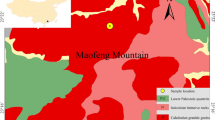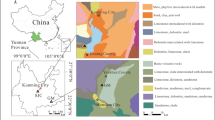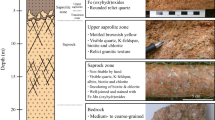Abstract
Geochemical and mineralogical studies were conducted on the 12-m-thick weathering profile of the Kata Beach granite in Phuket, Thailand, in order to reveal the transport and adsorption of rare earth elements (REE) related to the ion-adsorption type mineralization. The parent rock is ilmenite-series biotite granite with transitional characteristics from I type to S type, abundant in REE (592 ppm). REE are contained dominantly in fluorocarbonate as well as in allanite, titanite, apatite, and zircon. The chondrite-normalized REE pattern of the parent granite indicates enrichment of LREE relative to HREE and no significant Ce anomaly. The upper part of the weathering profile from the surface to 4.5 m depth is mostly characterized by positive Ce anomaly, showing lower REE contents ranging from 174 to 548 ppm and lower percentages of adsorbed REE from 34% to 68% compared with the parent granite. In contrast, the lower part of the profile from 4.5 to 12 m depth is characterized by negative Ce anomaly, showing higher REE contents ranging from 578 to 1,084 ppm and higher percentages from 53% to 85%. The negative Ce anomaly and enrichment of REE in the lower part of the profile suggest that acidic soil water in an oxidizing condition in the upper part mostly immobilized Ce4+ as CeO2 and transported REE3+ downward to the lower part of the profile. The transported REE3+ were adsorbed onto weathering products or distributed to secondary minerals such as rhabdophane. The immobilization of REE results from the increase of pH due to the contact with higher pH groundwater. Since the majority of REE in the weathered granite are present in the ion-adsorption fraction with negative Ce anomaly, the percentages of adsorbed REE are positively correlated with the whole-rock negative Ce anomaly. The result of this study suggests that the ion-adsorption type REE mineralization is identified by the occurrence of easily soluble REE fluorocarbonate and whole-rock negative Ce anomaly of weathered granite. Although fractionation of REE in weathered granite is controlled by the occurrence of REE-bearing minerals and adsorption by weathering products, the ion-adsorption fraction tends to be enriched in LREE relative to weathered granite.







Similar content being viewed by others
References
Bao Z, Zhao Z (2008) Geochemistry of mineralization with exchangeable REY in the weathering crusts of granitic rocks in South China. Ore Geol Rev 33:519–535
Bau M (1999) Scavenging of dissolved yttrium and rare earths by precipitating iron oxyhydroxide: experimental evidence for Ce oxidation, Y-Ho fractionation, and lanthanide tetrad effect. Geochim Cosmochim Acta 63:67–77
Boulangé B, Colin F (1994) Rare earth element mobility during conversion of nepheline syenite into lateritic bauxite at Passa Quatro, Minais Gerais, Brazil. Applied Geochem 9:701–711
Braun JJ, Pagel M, Muller JP, Bilong P, Michard A, Guillet B (1990) Cerium anomalies in lateritic profiles. Geochim Cosmochim Acta 54:781–795
Braun JJ, Pagel M, Herbillon A, Rosin C (1993) Mobolization and redistribution of REEs and thorium in a syenitic lateritic profile: a mass balance study. Geochim Cosmochim Acta 57:4419–4434
Cantrell KJ, Byrne RH (1987) Rare earth element complexation by carbonate and oxalate ions. Geochim Cosmochim Acta 51:597–605
Charusiri P, Clark AH, Farrar E, Archibald D, Charusiri B (1993) Granite belts in Thailand: evidence from the 40Ar/39Ar geochronological and geological syntheses. J Southeast Asian Earth Sci 8:127–136
Chi R, Tian J (2009) Weathered crust elution-deposited rare earth ores. Nova, New York, 288 pp
Cobbing EJ, Mallick DIJ, Pitfield PEJ, Teoh LH (1986) The granites of the Southeast Asian Tin Belt. J Geol Soc London 143:537–550
Cobbing EJ, Pitfield PEJ, Darbyshire DPF, Mallick DIJ (1992) The granites of the South-East Asian tin belt. Overseas Memoir of the British Geological Survey no. 10, HMSO, London, 369 pp
Compton JS, White RA, Smith M (2003) Rare earth element behavior in soils and salt pan sediments of a semi-arid granitic terrain in the Western Cape, South Africa. Chem Geol 201:239–255
Coppin F, Berger G, Bauer A, Castet S, Loubet M (2002) Sorption of lanthanides on smectite and kaolinite. Chem Geol 182:57–68
Department of Mineral Resources, Thailand (DMR) (1985) Geologic map of Thailand, NB47-2, 1:250,000. DMR, Bangkok
Duddy LR (1980) Redistribution and fractionation of rare-earth and other elements in a weathering profile. Chem Geol 30:363–381
Geological Survey of Japan (1994) Report of international Research and Development Cooperation ITIT Projects no. 90-1-2. Study on rare-earth resources in weathered granitoids in Thailand. Ministry of International Trade and Industry, Tokyo. 201 pp
Ishihara S (1977) The magnetite-series and ilmenite-series granitoids. Mining Geol 27:293–305
Ishihara S, Wang P (1999) The ilmenite-series and magnetite-series classification of the Yanshanian granitoids of South China. Bull Geol Surv Japan 50:661–670
Ishihara S, Renmin H, Hoshino M, Murakami H (2008) REE abundance and REE minerals in granitic rocks in the Nanling Range, Jiangxi Province, Southern China, and generation of the REE-rich weathered crust deposits. Resource Geol 58:355–372
Kosmulski M (2009) pH-dependant surface charging and points of zero charge. IV. Update and new approach. J Colloid Interface Sci 337:439–448
Laveuf C, Cornu S (2009) A review on the potentiality of rare earth elements to trace pedogenetic processes. Geoderma 154:1–12
Menon MP (1982) Solubility product constant and thermodynamic values for the terbium trifluoride-water system. J Chem eng Data 27:81–84
Mentani T (2011) So-called “ion-adsorption type” REE deposits found in weathered crust of ilmenite-series granite in northern Vietnam. Master’s thesis, University of Tokyo (unpublished)
Nakapadungrat S, Maneenai D (1993) The Phuket, Phangnga and Takua Pa tin-field, Thailand. J Southeast Asian Earth Sci 8:359–368
Nesbitt HW (1979) Mobility and fractionation of rare earth elements during weathering of a granodiorite. Nature 279:206–210
Nesbitt HW, Young GM (1982) Early Proterozoic climates and plate motions inferred from major element geochemistry of lutites. Nature 299:715–717
Ohta A, Kawabe I (2001) REE(III) adsorption onto Mn oxide (δ-MnO2) and Fe oxyhydroxide: Ce(III) oxidation by δ-MnO2. Geochim Cosmochim Acta 65:695–703
Pollard PJ, Nakapadungrat S, Taylor RG (1995) The Phuket Supersuite, southwest Thailand: fractionated I-type granites associated with tin-tantalum mineralization. Econ Geol 90:586–602
Putthapiban, P (1984) Geochemistry, geochronology and tin mineralization of Phuket granites, Phuket, Thailand. Ph.D. thesis, La Trobe University, Victoria, 414 pp (unpublished)
Rauret G, López-Sánchez JF, Sahuquillo A, Rubio R, Davidson C, Ure A, Quevauviller Ph (1999) Improvement of the BCR three step sequential extraction procedure prior to the certification of new sediment and soil reference materials. J Environ Monit 1:57–61
Roskill (2007) The economics of rare earths and yttrium, 13th edn. Roskill Information Services, Ltd., London, 275 pp
Sanematsu K, Murakami H, Watanabe Y, Duangsurigna S, Vilayhack S (2009) Enrichment of rare earth elements (REE) in granitic rocks and their weathered crusts in central and southern Laos. Bull Geol Surv Japan 60:527–558
Sanematsu K, Moriyama T, Sotouky L, Watanabe Y (2011) Mobility of rare earth elements in basalt-derived laterite at the Bolaven Plateau, southern Laos. Resource Geol 61:140–158
Schwartz MO, Rajah SS, Askury AK, Putthapiban P, Djaswadi S (1995) The Southeast Asian Tin Belt. Earth-Sci Rev 38:95–293
Sun SS, McDonough WF (1989) Chemical and isotopic systematics of oceanic basalts: implications for mantle composition and processes. In: Saunders AD, Norry MJ (eds) Magmatism in the ocean basins (Geological Society Special Publication, no. 42). pp 313–345
Suwimonprecha P, Černý P, Friedrich G (1995) Rare metal mineralization related to granites and pegmatites, Phuket, Thailand. Econ Geol 90:603–615
Thomas RP, Ure AM, Davidson CM, Littlejohn D, Rauret G, Rubio R, López-Sánchez JF (1994) Three-stage sequential extraction procedure for the determination of metals in river sediments. Anal Chim Acta 286:423–429
Topp SE, Salbu B, Roaldset E, Jørgensen P (1984) Vertical distribution of trace elements in laterite soil (Suriname). Chem Geol 47:159–174
U.S. Geological Survey (2010) U.S. Geological Survey, Mineral Commodity Summaries, Yttrium. pp 184–185
Ure AM, Quevauviller PH, Muntau H, Griepink B (1993) Speciation of heavy metals in soils and sediments. An account of the improvement and harmonization of extraction techniques undertaken under the auspices of the BCR of the Commission of the European Communities. Int J Environ Anal Chem 51:135–151
Wood SA (1990) The aqueous geochemistry of the rare-earth elements and yttrium. 1. Review of available low-temperature data for inorganic complexes and the inorganic REE speciation of natural waters. Chem Geol 82:159–186
Wu C, Ishihara S (1994) REE geochemistry of the Southern Thailand granites. J Southeast Asian Sci 10:81–94
Wu C, Huang D, Guo Z (1990) REE geochemistry in the weathered crust of granites, Longnan area, Jiangxi province. Acta Geol Sinica 3:193–210
Xing B, Dudas MJ (1993) Trace and rare earth element content of white clay soils of the Three River Plain, Heilongjiang Province, P.R. China. Geoderma 58:181–199
Acknowledgments
We are grateful to Mr. Jarupong Boosayasake and Dr. Pinyo Meechumna of Chulalongkorn University for the support during fieldwork in Thailand. We thank Mr. Shingo Ishida and Dr. Yoshinobu Motomura for helping in the field and with chemical analyses. Part of this study has been financially supported by a grant-in-aid (no. 19253005, leader Dr. Yasushi Watanabe) provided by Japan Society for Promotion of Science (JSPS).
Author information
Authors and Affiliations
Corresponding author
Additional information
Editorial handling: B. Lehmann
Rights and permissions
About this article
Cite this article
Sanematsu, K., Kon, Y., Imai, A. et al. Geochemical and mineralogical characteristics of ion-adsorption type REE mineralization in Phuket, Thailand. Miner Deposita 48, 437–451 (2013). https://doi.org/10.1007/s00126-011-0380-5
Received:
Accepted:
Published:
Issue Date:
DOI: https://doi.org/10.1007/s00126-011-0380-5




